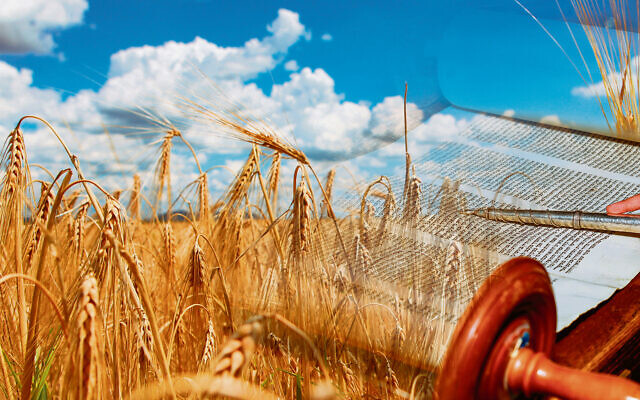The silent, still voice of Shavuot
There is so much more to Shavuot than cheesecake and blintzes.
Each year we celebrate three biblically prescribed festivals. The first is Pesach. Who does not know when Pesach is approaching? After all, so much effort goes into preparing every household for the festival of Pesach and the sedarim that are its highlight. Our kosher butchers go kosher l’Pesach at least six weeks before Pesach – that’s as much preparation time as there is during the Omer period between Pesach and Shavuot.
Similarly Succot, the third of the pilgrimage festivals, follows hard on the heels of the high holy day season for which preparations (with sounding the shofar) begin six weeks earlier, on Rosh Chodesh Elul. That aside, Succot itself also requires specific preparations that signify its approach (building a succah, acquiring lulav and etrog).
But Shavuot?
Shavuot is the “kol demamah dakah – the silent still voice” of our festival calendar. Also known as “Atzeret – the day of refraining from work” (Mishnah Rosh Hashanah 16a and Gemara Pesachim 68b) – in our contemporary post Temple era it is a chag lacking any obvious mitzvot other than observance of general yom tov laws celebrated from the biblical perspective for just one day (only in the Diaspora does one celebrate two days). Thus it is simply a point in time.
True that point in time comes at the end of a week of weeks, the seven week Omer period that gives it its most popular name, Shavuot (meaning weeks). And indeed that Omer period serves as a time of spiritual preparation for the Torah related spiritual significance of this otherwise agricultural harvest festival (Chag Hakatzir).
But being essentially only one day and lacking mitzvot in the form of symbolic practices, it seems almost insignificant compared to the other festivals that each involve the full basic time cycle of one week, as well as their specific mitzvot. (Note: Such was not the case in Temple times. The Omer offering of barley which was brought on 16 Nissan and from which we count seven weeks made all the new grains permissible only for private consumption. In the Beit Hamikdash, however, they could not bring any meal-offerings from the new grain until they offered the shtei halechem – two loaves – from bikkurim, the first wheat grains, on Shavuot. Also in the Beit Hamikdash, albeit the chag lasted only one day, the obligation on each male to bring a chagigah sacrifice could be fulfilled in the ensuing six days so that in that context at least Shavuot had a seven-day aspect.)
However, as we reflect further, we find that albeit just a point in time, this very time-related dimension provides so much more content and meaning to this festival. That very element of time – z’man – is to be found also in another of its names – Z’man Matan Toratenu, the time of giving of our Torah.
But, what time is indeed referred to by that name, which features so widely in the kiddush and other prayers on Shavuot? It was the time at which a disparate group of just-freed slaves became, as we read from the Torah on the first day, “mamlechet kohanim v’goy kadosh, a kingdom of priests and a holy nation” (Shemot 19:6).
And in that context, this comparatively silent Shavuot festival continues to reverberate throughout the generations in which the Torah, then received, continues to dominate our lives. Thus the words that follow the second description in the Torah of the day on which it was given are literally fulfilled: “These words the Lord spoke to all your assembled congregation on the mountain from the midst of the fire, smoke and cloud, a mighty voice which did not cease…” (Devarim 5:19; see Talmud Sanhedrin 17a).
Of course, some look at that verse and ask an obvious question: What is meant by the sound that reverberates and did not cease? Do we really hear such a sound anywhere? Does it really exist?
And in that regard, I draw on an answer I once heard from the late Rabbi Chaim Gutnick in the name of Rav Eliyahu Dessler of Gateshead Kollel and (subsequently) the Ponevicz Yeshivah in B’nei B’rak.
Indeed, he stated in dramatic fashion, even the most silent of rooms in which we may stand at any given time is actually filled with a multiplicity of sounds.
To which you might respond: really? How come all we experience is silence? And the answer is – all you need is a radio. All one needs is the right instrument, and then one can tune into so many sounds around us of which we are otherwise totally unaware. So it is in regard to the voice emanating from Sinai. We only need to turn on the right instrument to hear the sounds that are already there, filling the atmosphere and the world.
That is where Shavuot comes into the picture. It may not have other observances to keep us busy, but it is an instrument that on reflection serves to help us tune into the voice still reverberating from Sinai.
And if you want evidence it is there in plenty. Look at how much Torah study takes place worldwide on the night of Shavuot even today, well over three millennia after the Torah was given. Thus we too continue to hear that voice reverberating since Sinai and until the end of days.
And so I conclude – make sure you too participate in one of the many “Tikun Leil Shavuot” learning or lecture progams at your respective shules this coming Motzaei Shabbat.
Chag sameach v’Shabbat shalom,
Yossi
Yossi Aron OAM is The AJN’s religious affairs editor.


comments